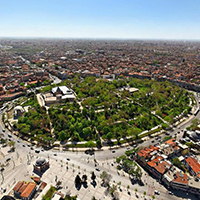Evaluation of Urban Spaces from the Perspective of Universal Design Principles: The Case of Konya/Turkey
Abstract
During the process of accessing services provided within urban interior and outer spaces the elderly and disabled individuals encounter with a myriad of problems due to the limitations posed by structured environments. This limitation hinders elderly and disabled individuals from mobility without assistance, which in turn negatively affects their full participation to urban and social life. Rearrangement of urban spaces to meet the needs of elderly and disabled individuals would correspondingly bolster life quality of the entire range of users. Within the scope of present research, as mandated by universal design principles to stick to plans and designs approaches inclusive for all users, it is aimed to conduct evaluations on the use of urban outer spaces situated within Konya city center. In the hypothetical and theoretical part of this paper, the perception of disability throughout historical process has been examined from a sociological perspective. In addition, concept of universal design, its principles and gravity have also been elaborated. In the part dealing with the case study, outer spaces within Konya city center have been analyzed with respect to universal design principles and a range of suggestions have been developed.
Downloads
References
Brisenden, S. (1998). Independent living and the medical model of disability. In T. Shakespeare (Ed.), The disability reader: Social science perspectives (20-27). London and New York: Cassell. doi: http://dx.doi.org/10.1080/02674648666780171
Centre for Universal Design. (2011). The new principles of universal design. Centre for Universal Design, College of Design, North Carolina State University. Retrieved from http://www.ncsu.edu/project/design-projects/udi/center-for-universal-design/the-principles-of-universal-design/.
Charlton, J.I. (1998). Nothing about us without us: Disability of oppressions and empowerment. Berkeley, Los Angeles/London: University of California Press.
Dostoglu, N., Sahin, E. & Taneli, Y. (2009). Inclusive approach to design: Design for all, universal design: definitions, objectives, principles (in Turkish: Tasarıma kapsayıcı yaklaşım: Herkes için tasarım, evrensel Tasarım: Tanımlar, hedefler, ilkeler). Mimarlık, 347. doi: http://dx.doi.org/10.1080/dre.25.2.57.66
Goldsmith, S. (1976). Designing for the disabled problems of conflicting criteria. MA (contab) Riba Publicotions Limited. London, 65–77.
Kaplan, H. (2007). As a component of urban design; barrier-free design for providing accessibility and legibility of the urban space. File 04, Chamber of Architects Ankara Branch, 51-62. doi: http://dx.doi.org/10.1080/0968759032000052914
Oliver, M. (1990). The politics of disablement: A sociological approach. New York: St. Martin's Press.
Ozarslan, A. (2010). A study of the feasibility of barrier-free space design at a university campus (Master Thesis). Gazi University Institute of Science Technology, Ankara, Turkey. doi: http://dx.doi.org/10.1109/IEMBS.2007.4353411
Turkish Statistical Institute. (2010). Survey on problems and expectations of disabled people, Turkish Statistical Institute. Retrieved from http://www.Turkish Statistical Institute.gov.tr/ (Accessed 12th May 2015).
United Nations. (2004). Accessibility for the disabled a design manual for a barrier-free environment. Retrieved from http://www.un.org/esa/socdev/enable/designm/ (Accessed 06th February 2016).
United Nations. (2006). Convention on the rights of persons with disabilities and optional protocol. Retrieved from http://www .un.org/disabilities/documents/convention/convoptprot-e.pdf (Accessed 03th Apr 2016).
Winter, J.A. (2003). The development of the disability rights movement as a social problem solver. Disability Studies Quarterly, 23(1) 33-61.

Copyright (c) 2016 Tema. Journal of Land Use, Mobility and Environment

This work is licensed under a Creative Commons Attribution 4.0 International License.
Authors who publish in this journal agree to the following:
1. Authors retain the rights to their work and give in to the journal the right of first publication of the work simultaneously licensed under a Creative Commons License - Attribution that allows others to share the work indicating the authorship and the initial publication in this journal.
2. Authors can adhere to other agreements of non-exclusive license for the distribution of the published version of the work (ex. To deposit it in an institutional repository or to publish it in a monography), provided to indicate that the document was first published in this journal.
3. Authors can distribute their work online (ex. In institutional repositories or in their website) prior to and during the submission process, as it can lead to productive exchanges and it can increase the quotations of the published work (See The Effect of Open Access)
